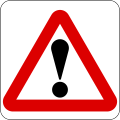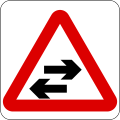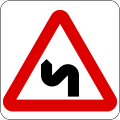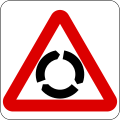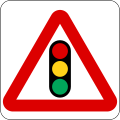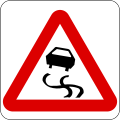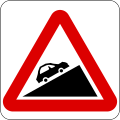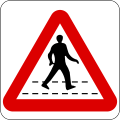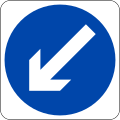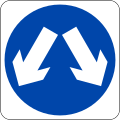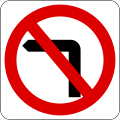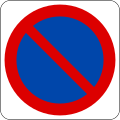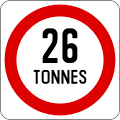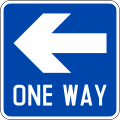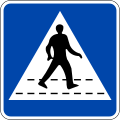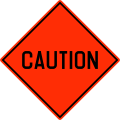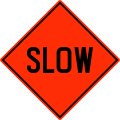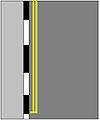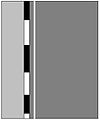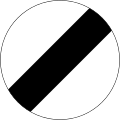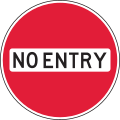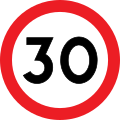Road signs in Singapore
This article needs additional citations for verification. (March 2025) |
Road signs in Singapore closely follow those laid down in the United Kingdom's traffic sign regulations, although a number of changes over the years have introduced some slight deviations that suit local road conditions (such as fonts). Road signs in Singapore conform to the local Highway Code under the authority of Singapore Traffic Police.
The typeface used, which is regulated by the Land Transport Authority, has no official name.[1] It is also used on road signs in Brunei.
Since the mid-1990s, signs have been placed on a backing board, making them square or rectangular and standardised to a width of 600 mm on most roads and 900 mm on expressways. Prior to the 1990s and after 1964, signs were cut out to their shape (for example, round signs were cut to be circular) as in most countries around the world. Prior to 1964, signs were in the pre-Worboys style with a couple of differences.
Singapore traffic signs display text in English, one of the four official languages and the main language in the country. The three others – Malay, Chinese, and Tamil – as well as Japanese are also used for important public places such as tourist attractions, airports and immigration checkpoints.
Warning signs
[edit]Warning signs indicate possible dangers or unusual conditions ahead and alert motorists, so they may anticipate the appropriate actions to take. They are usually shaped as triangles with a red border, and mounted on a borderless white backing board.
-
Danger
-
Other dangers nearby
-
Accident blackspot
-
Restricted Zone ahead
-
Electronic Road Pricing (road toll) gantry ahead
-
Road Hump
-
Uneven road
-
Road narrows on right
-
Road narrows on both sides ahead
-
Two-way traffic crosses a one-way road
-
Two-way traffic ahead
-
Lanes merge ahead
-
Double curve first to left (or to the right if the symbol is reversed)
-
Dual carriageway ends
-
Crossroads
-
Side road on left
-
Side road on right
-
T-junction
-
Traffic merging from left
-
Staggered junction
-
Roundabout ahead
-
Traffic lights ahead
-
Traffic queues expected ahead
-
Slippery road
-
Steep ascent
-
Steep descent
-
Quayside or river bank ahead
-
Tunnel ahead
-
Low flying aircraft
-
Pedestarian crossing
-
Curve to the right ahead (Left if symbol is reversed)
-
Advance warning of a height restriction ahead
-
School zone
-
Horses
-
Pedestrians on road ahead
-
Elderly or blind people ahead
-
Slow down
-
Maintain a slow speed to anticipate hazards ahead
-
Bridge with low headroom ahead
-
Chevron
Regulatory signs
[edit]Regulatory signs either mandatory, which give positive instructions, or prohibitory, which indicate a prohibition. Many regulatory signs are accompanied by supplementary plates that provide interdependent exceptions to the rule, or indicates additional instruction or information to facilitate understanding of the rule implemented.
Mandatory signs
[edit]Mandatory signs are generally circular with a white border and symbol on a blue background. They usually indicate something all drivers must do (e.g. keep left) or a facility available to certain classes of traffic (e.g. pedal cycles only).
-
Ahead only (Turning left and right is prohibited)
-
Turn left ahead (right if symbol is reversed)
-
Turn left (right if symbol is reversed)
-
Keep left (Right if symbol is reversed)
-
Split-way, i.e. motorists can pass to either side, but either side might not reach the same destination
-
Route to be used by pedal bicycles only
-
Route to be used by motorcycles only
Priority signs
[edit]The exceptions are the octagonal red STOP sign, the temporary STOP and GO signs and the triangular GIVE WAY sign.
-
Stop, children crossing
-
Temporary stop signs
-
Temporary go signs
Prohibitory signs
[edit]Prohibitory signs, which generally tell drivers what they must not do, are mostly circular and have a red border. The red ring indicates the prohibition; diagonal bars are used only on signs which prohibit a specific manoeuvre, i.e. banned left or right turns and U-turns, or a certain class of vehicle, i.e. lorries
-
No entry
-
No left turn
-
No right turn
-
No trucks
-
No vehicles with 3 axles or more
-
No vehicles carrying explosives
-
No pedal bicycles
-
No Waiting
-
No stopping
-
No overtaking
-
No horning, unless to prevent an accident
-
No jaywalking
-
No jaywalking in the bus park
Diagonal bars are excluded when restrictions are quantitative in nature, i.e. limits in speed, weight, axle, height, and width.
-
No vehicles over height shown. Vehicles taller than 4.5m requires a police escort.
-
No vehicles over width shown
-
No vehicles over weight shown
-
Maximum speed limit in kilometres per hour (km/h)
Information signs
[edit]Information signs are signs that may be mounted to indicate a certain condition or nature of the road ahead that motorists need to take note. They are independent of existing mandatory and prohibitive signs. Such signs are usually white or blue and rectangular in shape.
-
U-turn allowed DIRECTLY AFTER the sign. Do not U-turn when there is no sign.
-
One-way traffic
-
Pedestarian crossing
-
Parking zone for cars - Coupon Payment (in Transport typeface)
-
Parking zone for Motor- Coupon Payment (in Transport typeface)
-
Dead end
-
Dead end on the left ahead
-
Dead end on the right ahead
-
End of restricted zone
-
Keep a safe distance from vehicle in front
-
Speed regulating strips ahead
-
Right turn lanes ahead
-
Watch out for traffic from side road
-
Reminder to look out & give way to pedestrians crossing when making a right turn
-
When "B" lights up in green, public buses from left lane proceed before green light for all other vehicles
-
When "B" lights up in green, public buses proceed after exiting bus bay before green light for all other vehicles
-
Advisory Give-way-to-buses-exiting-bus-bay rule ahead
-
Mandatory Give-way-to-buses-exiting-bus-bay rule ahead
-
Speed camera ahead
-
Red light camera
-
Expressway
-
End of expressway
-
Concealed exit ahead. Watch out for traffic coming from a concealed side road.
-
U-Turning vehicles keep right
-
Do not drive on the road shoulder
-
Dual carriageway ahead
-
Layout of traffic lanes ahead (for lane formation)
-
Expressway name and distance marker
Temporary work-zone signs
[edit]Temporary work-zone signs (designated in amber orange signages) are mounted to ensure road users are notified in advance despite being affected by road works in the vicinity. It closely follows the American MUTCD traffic sign (e.g. reddish orange diamond, reddish orange rectangular or amber rectangular-shaped signs).
-
Advance sign of road works ahead
-
Indication of road stretch affected by road works
-
Entry to works area
-
Heavy vehicles turning ahead
-
Heavy vehicles turning ahead
-
Layout of lanes ahead
-
Road narrows on right ahead
-
Slow
-
Slow down
-
Temporary roundabout
-
Temporary mandatory speed limit (40 km/h)
-
Temporary traffic lights ahead
-
Curve to right (Left if symbol is reversed)
-
Supplementary plate to specify direction indicated for temporary road rule
-
Beware Of Turning Vehicles
-
Chevron
-
Temporary Hight limit
-
Detour for pedestrians in direction indicated (Right)
-
Other dangers nearby
Directional signs
[edit]- Signs indicating destinations reached via expressways has white lettering on a blue background.
- Signs indicating destinations reached via other roads have white lettering on a green background.
- Signs indicating local destinations have black lettering on a white background.
- Signs indicating recreational facilities and landmarks have white lettering on a brown background.
-
On approach to a junction (single direction)
-
At the junction
-
On approach to a roundabout
-
Get in lane with respect to the destinations stated above each downward-pointing lane arrow
-
Direction to a place of interest
Road markings
[edit]Along the side of the road
[edit]-
No parking between 7 am to 7 pm (Daily with the exception of Sundays and Public Holidays)
-
Option 1 (Advisory) No waiting at any time, unless there are signs that specifically indicate seasonal restrictions.
-
Option 2 (Mandatory) No waiting at any time, unless there are signs that specifically indicate seasonal restrictions.
-
Clearway (No stopping) on that side of the road at any time
-
Indication of a zebra crossing ahead.
-
Edge line (used along roads, not in built-up areas, or divide the road shoulder of an expressway from the inside lane)
Road dividers
[edit]-
Keep left of the divider
-
Keep left of the diagonally hatched divider
-
Keep left of the divider; no waiting on either side of the road at any time
-
Keep left of the unbroken diagonally hatched divider; No crossing of the divider
-
Keep left of the divider; no crossing of the divider in either direction at any time.
-
Zebra crossing ahead; keep left of the divider.
Historic signs
[edit]The following signs are historical, and are now obsolete.
Post-Worboys
[edit]-
National Speed Limit Applies (1964–1990s)
-
No U-turn (1964–1990s)
-
Indication of a U-turn lane, on the lane closest to the road divider or carriageway (1964–1990s)
-
Level crossing with gates (prior to June 2011)
-
Level crossing with no gates (prior to June 2011)
-
Level crossing (prior to June 2011)
Pre-Worboys
[edit]-
No Through Road For Motor Vehicles
-
No Entry
-
No Right Turn
-
Cross Roads
-
Turn Left
-
Keep Left
-
Road Works Ahead
-
Ford
-
No Waiting
-
No Entry
-
No Cycling
-
Speed Limit
-
National Speed Limit Applies
-
Parking
-
Cross Roads
-
Speed Limit except Built-up Areas
-
Turn Right
-
Roundabout
-
No Left Turn
-
Signals Ahead
-
Two Way Traffic
-
Level Crossing with No Gates
-
Halt at major road ahead
-
Slow, major road ahead
-
Motor vehicles prohibited
See also
[edit]References
[edit]- Singapore Official Highway Code (Basic Theory of Driving) Seventh Edition. ISBN 978-981-04-0567-0 . Published 2008 by Pacific Communications Pte Ltd under the authority of the Traffic Police.
- ^ "Standard Details of Road Elements - Chapter 7: Directional Signs" (PDF). lta.gov.sg. Land Transport Authority. Retrieved 23 March 2025.
External links
[edit]- LTA Feedback Portal
- Provides information about LTA, major projects and other services
- DA Roadsigns, a replica of the Singaporean road sign typeface


